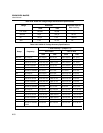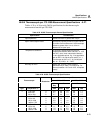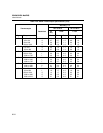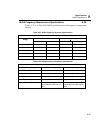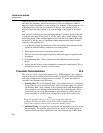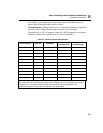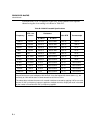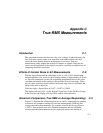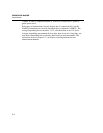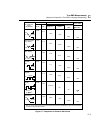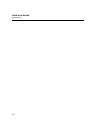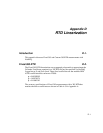
2640A/2645A NetDAQ
Users Manual
B-2
reading rate and scan interval that is an exact multiple of the power line period
and cause line frequency noise to be aliased to a very low frequency, where it
appears as drift, or instability, in the readings. For example, if the instrument is set
to Reading Rate = Fast and a scan interval of 100 ms, line frequency noise is
aliased because the scan interval is an exact multiple of the period of the power
line.
One way to see whether your measurement setup has a potential problem like this
is to pick a scan interval like 98 ms or 102 ms, that is not an exact multiple of the
power line period. If the readings appear noisier with this scan interval than with
an interval of 100 ms, there is a problem with the measurement setup. Possible
solutions to this problem are:
1. Use shielded wiring to prevent power line noise pickup from mixing with the
signal. Be sure the shield is connected to an earth ground.
2. Route signal wiring away from power mains wiring.
3. Remove noise from the signal using filters before the signal is applied to the
instrument.
4. Select Reading Rate = Slow, which allows the instrument to filter out the
noise.
5. Ensure that the chassis of the instrument is connected to earth ground. This is
desirable for reasons of safety as well as noise.
Crosstalk Considerations B-4.
The accuracy of low voltage measurements (e.g., thermocouples), low voltage ac
measurements and resistance measurements above 3 kΩ can be greatly affected by
undesired pickup from ac voltage sources (crosstalk). To reduce the effects of
crosstalk, consider each of the following:
1. Reading Rate Do not use Reading Rate = Fast when mixing vac or frequency
inputs with low level vdc, thermocouple, and/or resistance inputs. If you must
use Reading Rate = Fast, compare a set of readings taken with Reading Rate =
Slow against a set of readings taken on the Fast rate to determine the effects
of crosstalk on your setup. Measurements made at the Fast reading rate are
more susceptible to crosstalk than readings taken at the Slow reading rate.
Note
When you use the Fast rate, it is very easy to get noise into your
readings. The Fast rate makes it possible to look at rapidly changing
events, but it requires extreme care to keep the readings clean.
2. Shielded Wiring Crosstalk can occur outside the instrument as well as inside
the instrument. Use shielded wiring and tie the shields to an earth ground to
prevent noise from being coupled into your measurements. Be careful about



